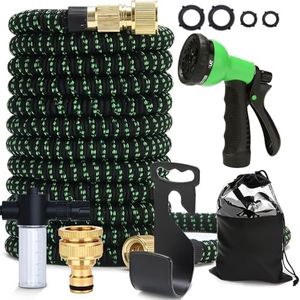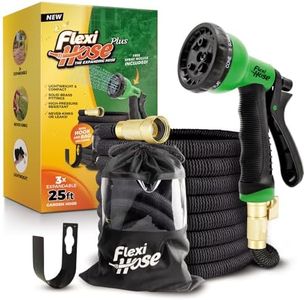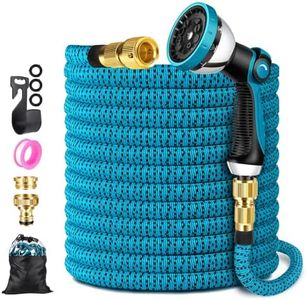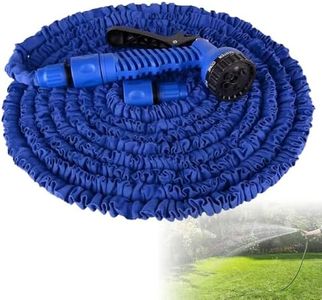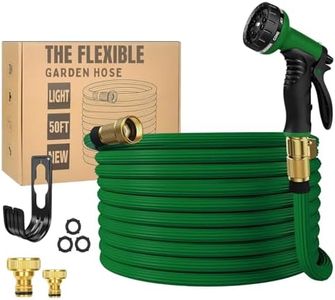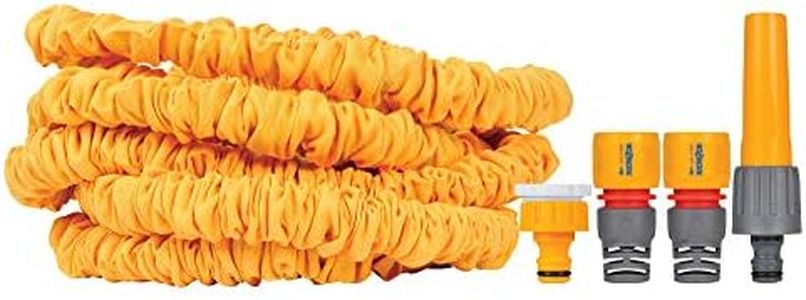We Use CookiesWe use cookies to enhance the security, performance,
functionality and for analytical and promotional activities. By continuing to browse this site you
are agreeing to our privacy policy
10 Best Expandable Hose
From leading brands and best sellers available on the web.Buying Guide for the Best Expandable Hose
When choosing an expandable hose for your watering or cleaning needs, it helps to understand what features will make the hose work best for you. Expandable hoses are popular because they are lightweight, easy to store, and automatically expand when water is turned on. To find the one that fits your requirements, you need to look at a few key specifications. Think about where you'll use it, how often, and for what tasks the hose is needed—this will help you narrow your choices and pick the right expandable hose for your home or garden.Hose LengthHose length refers to how long the hose becomes when it is fully expanded with water. The most common lengths range from about 25 to 100 feet. This matters because the hose needs to reach all the places you want to water or clean. Shorter hoses (around 25 feet) are easier to manage and store but might not reach distant garden beds, while longer hoses (75-100 feet) offer more reach but can be heavier and take longer to coil. To choose the right length, measure the maximum distance from your water source to the farthest area you want to reach, and pick a hose that covers that distance when expanded.
Material QualityThe materials used in an expandable hose affect its durability and performance. Most have an inner tube made from latex or TPC and an outer layer made from polyester or plastic fabric. Higher-quality hoses use double or triple-layer latex for better flexibility and resistance to punctures. A strong outer fabric helps protect the hose from wear, kinks, and damage from dragging on the ground. If you need a hose for regular, everyday use, or if you have rough outdoor surfaces, look for hoses with stronger materials and thicker outer layers. For light, occasional use, basic material construction may suffice.
Fittings and ConnectorsFittings are the parts that attach the hose to your water tap and to sprayers or nozzles. They come in materials like brass, aluminum, or plastic. Brass fittings are the most durable and the least likely to leak or break, making them a good choice for frequent use or for connecting to metal taps. Plastic fittings are lighter and less expensive, but they can wear out faster and may not withstand high water pressure. Consider choosing solid metal fittings if you want reliability, especially if you plan to connect and disconnect your hose often.
Water Pressure CompatibilityWater pressure compatibility indicates the maximum pressure the hose can handle before it risks bursting. Expandable hoses are best suited for moderate household water pressures. Most can withstand about 40-80 PSI (pounds per square inch). If your water pressure is too high, it can damage the hose; if it's too low, the hose may not fully expand. Check your local water pressure if you're unsure, and select a hose that matches that range. If you experience high water pressure, look for hoses specifically built for higher PSI.
Weight and StorageWeight is important if you need to move the hose frequently or if storage space is tight. Expandable hoses are much lighter than traditional rubber hoses, making them ideal for seniors, people with limited strength, or anyone who dislikes lugging around a heavy hose. Most standard hoses weigh only a couple of pounds. If storage space is a concern, select a hose that compresses to a compact size and comes with a storage bag or hanger. Think about where you’ll be keeping the hose and how easy it will be to pack away after each use.
